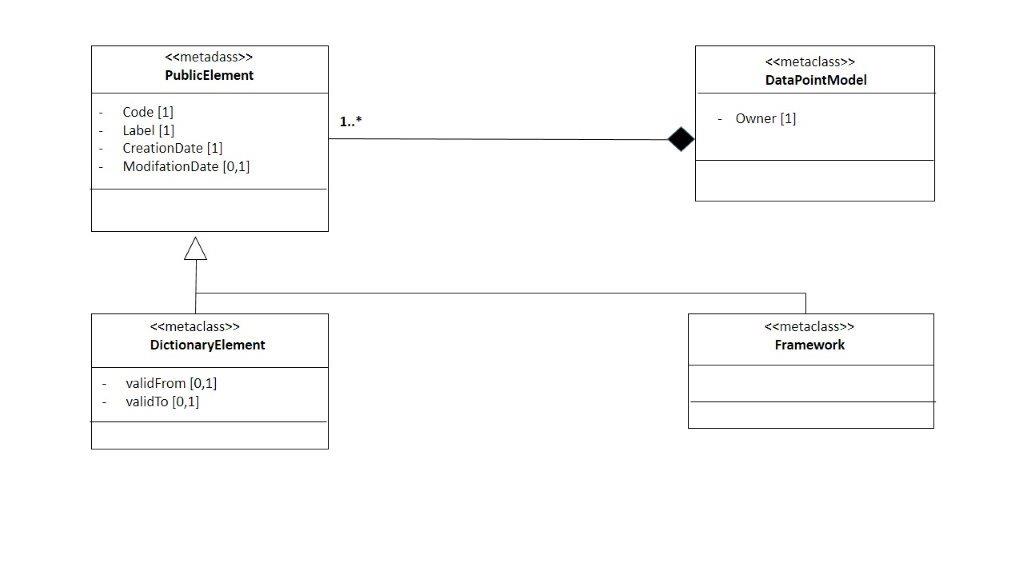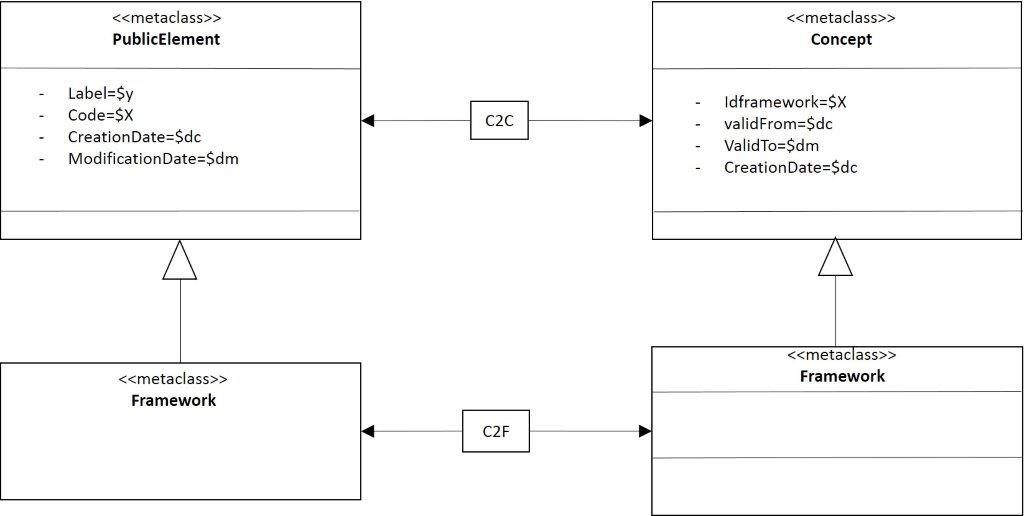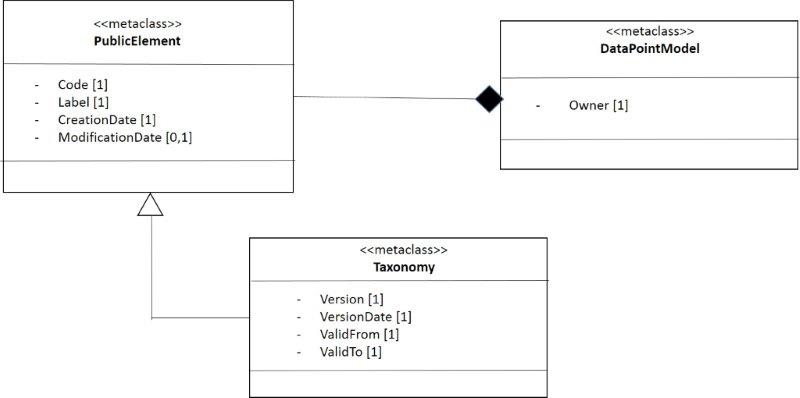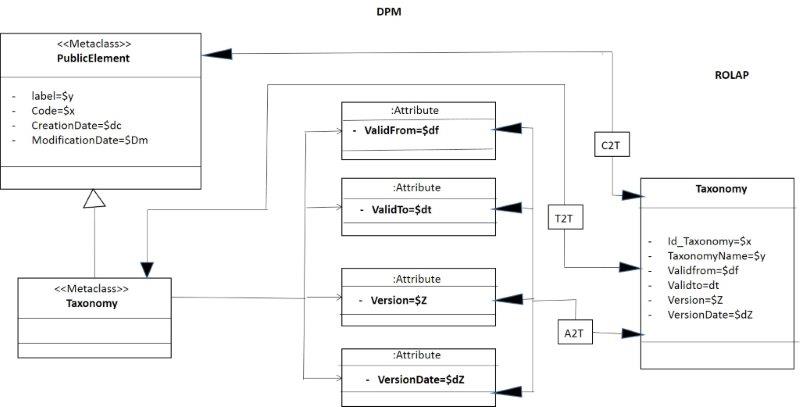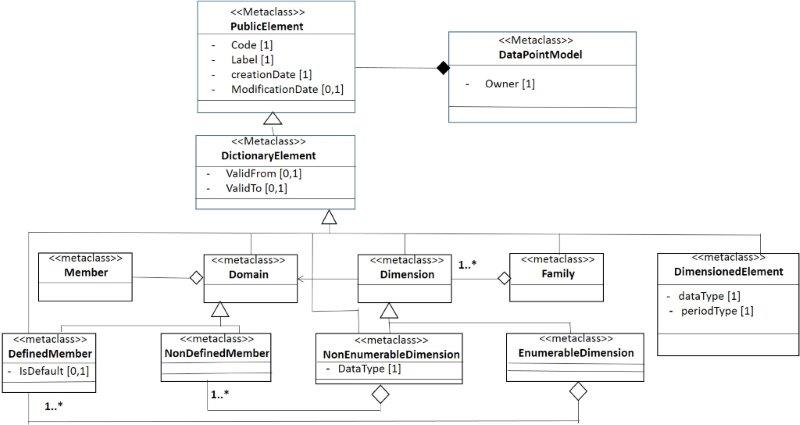DPM2MDM
From XBRLWiki
| Revision as of 10:29, 18 September 2013 (edit) Ignacio.santos (Talk | contribs) ← Previous diff |
Revision as of 10:36, 18 September 2013 (edit) Ignacio.santos (Talk | contribs) Next diff → |
||
| Line 157: | Line 157: | ||
| In this section is defined the mapping of the constructor dimension. The figure 5 shows a perspective of the structure of the dimension [11] [22]. | In this section is defined the mapping of the constructor dimension. The figure 5 shows a perspective of the structure of the dimension [11] [22]. | ||
| + | |||
| + | [[Image:Presentacion2U_F5Peq.jpg]] | ||
| + | ;Figure 5.- Structural perspective of the dimension. | ||
| + | |||
| + | This figure shows two types of dimensions [9] [10], the implicit and the typed dimension. But in an upper level is the family or group of dimensions and they belong to a same domain. If the dimension is explicit then this contains a set of members. Each domain has one and only one member by default. An explicit dimension consists of a number of members, called domain-member, and therefore is enumerable. On the other hand, a typed dimension is not enumerable because its member are not known in advance. | ||
| + | |||
| + | The figure 6 shows only the mapping of the explicit dimension. Where the transformation between ''DictonaryElement'' (DPM) and ''Concept'' (RM) is detailed a little more, for comprehension of the reader. | ||
| + | |||
| End modification ----------------------- | End modification ----------------------- | ||
Revision as of 10:36, 18 September 2013
CEN Workshop Agreement
CEN WS XBRL Experts: Ignacio Santos (Bank of Spain)
Foreword
This document has been prepared by CEN/WS XBRL, the secretariat of which is held by NEN. CWA XBRL 001 consists of the following parts, under the general title Improving transparency in financial and business reporting — Harmonisation topics:
- Part 5: Mapping between DPM and MDM
General
The purpose of this document is to present and explain the mapping between the Data Point Model (DPM) and the Multidimensional Data Model (MDM) [1] [2] [3] [4] [5], through the Relational Model using ROLAP analytic tool. This document is based in a work presented in Banca D’Italia, Rome, in September 2011 [20]. ROLAP is defined as Relational Online Analytical Processing. The DPM is a semantic model (Logical Model). Experts in the supervision in Europe have created the DPM, and as they are not software Engineers, they have important difficulties, especially with the XBRL specification [6]. XBRL taxonomies are metadata that provide a formal description of the data requirements to be used as data format in this case in the European reporting process. This document intends also to supply a description for IT experts about the linkage between a DPM as source and a relational data base as target of a transformation process.
The objective of the European XBRL Taxonomy Architecture (EXTA), is to set a framework or set of architecture guidelines that enables a Discoverable Taxonomy Set (DTS) author to create an XBRL taxonomy. However in this document expect to help to design the taxonomy through the DPM and in turn, it can implement the DPM in a Database. But, moreover, to help to Information System (IS) to have a better comprehension of the metadata. Comment-01
This project is funded by the EU commission to support the standardization process for supervisory reporting in Europe.
Objective
The objective of the EXTA is to define a set of architecture guidelines that transform a European DPM without a loss in quality in a XBRL format. The taxonomy architecture provides a set of rules for this transformation to enable the creation of consistent and predicable XBRL meta definitions in an automated process. On the other hand CEN WS has built a guidelines for mapping the DPM in the MDM. In such a way that the architect of IS can understand and/or mapping the DPM to ROLAP.
Target Audience
EXTA is targeted at taxonomy authors. Initially organizations like European Banking Authority (EBA), European Insurance and Occupational Pensions Authority (EIOPA), European Securities and Markets Authority (ESMA), European Central Bank (ECB) are the authors of these taxonomies. As a spin-off of these taxonomies, local (national) initiatives will emerge, hosted by National Supervisory Agencies (NSA’s). The audience of this document are financial or economic institutions, agencies, companies, or Universities that they want to implement the taxonomies in a relational model.
Relationship to other work
The reader of this EXTA is expected to be familiar with the principles of data modelling and have an understanding of the XBRL family of the specification. But, also, it is necessary to have a knowledge in the relational model and in the MDM.
Contents |
Scope
The DPM has been defined for the creation of Data Point Models in the context of European supervisory reporting. Data Point Model by an European supervisory authority. To reflect the defined structures in a machine-readable from the can be accompanied by an XBRL taxonomy. It is also possible to extend the described methodology to other environments as Database. Comment-02
Terms and definitions
For the purposes of this document, the following terms and definitions apply. The terms definitions used in the mapping with Data Point Model are inspired by vocabulary already known through their use for describing multidimensional databases and data warehouses. IT specialists originally introduced these terms. However, for an understanding and creation of Data Point Models they are established in the language of business specialists as well.
In this section are shown the set of definitions necessaries for mapping the DPM in ROLAP. The majority of the definitions are obtained of [6] [7] [8] [9] [10]. When the definition is in the area of CEN WS XBRL (Main Page) [11] [22] only is shown a hyperlink to definition.
The terms used directly or indirectly in the mapping of DPM in the MDM are:
- Concept.
- Data Point Model.
- Dimension.
- Domain.
- Family.
- Framework.
- Item.
- (Domain) member.
- Metric.
- Namespace.
- Owner.
- Perspective.
- Public elements.
- TableGroup.
- DataPoint.
- DataCube.
- Module.
- Hypercube.
A hypercube is an abstract item declaration in the xbrldt:hypercubeItem substitution group. A Hypercube is an ordered list of dimensions, defined by the set of zero or more dimension declarations linked to the hypercube by hypercube-dimension relationships in a dimension relationship set, and ordered according to the order of this relationship [10].
In the DPM a hypercube is reflect in the DataCube. A DataCube is a set of DataPoints with its appropriate Dimensions and Members.
A hypercube in the MDM is a set of pairs <dimension, attributes of dimension> and calculated attributes defining one or more facts [19].
- Taxonomy.
- Context.
The context element contains information about the entity being described, the reporting period and the reporting scenario, all of which are necessary for understanding a business fact captured as an XBRL item [6].
In the MDM, the context is defined as a set of dimension of a fact or group of facts. A context belongs to an entity or financial institution, for a period, a meaning for the business (segment), and a scenario. The scenario shows the specific pairs of dimension and the dimension attribute of business logic [9].
Mapping from Data Point Model to Multidimensional Data Model
Introduction
This section presents the mapping between the DPM and the Relational model through ROLAP. In this mapping is not expected the transformation to XBRL taxonomies, however is possible its conversion [20]. Moreover, also, in this transformation is not established any process of validation. It is only mapped the DPM structure in the Relational model. However, it is expected that the reader of this document can understand better the DPM or even that the reader can store the DPM in a RDBMS (Relational Database Management System), using the MDM.
There are a lot of bibliography about the mapping from different sources to a relational database especially from XML [12] [13] [15] [21], and about query in heterogeneous sources is interesting the paper of Levi et al. [14]. Nevertheless, the process of transformation of this section is based in Taentzer et al. [15}. This section will go step to step with the different constructors that they are corresponding in the DPM.
In this section the process of conversion is analysed. Normally, in a first step is to study the DPM element or element to transform. After, the mapping between the DPM element and the Relational elements. The transformation process in the figures show the DPM UML graph on the left hand side to UML class diagram to display the Relational model (ROLAP) from MDM. The black arrows between both UML language but customized extensions which are used to describe the graph transformation. The square between two black arrows contains an abbreviation what is begin mapped. In this document are distinguished the next different types of mappings rules between the two graphs [15]:
- C2C is the automatic transformation between concepts.
- C2F is the automatic transformation between concepts and frameworks.
- C2T is the automatic transformation between concepts and taxonomy.
- A2T is the automatic transformation between attributes to taxonomy.
- T2T is the automatic transformation between taxonomies.
- A2A is the automatic transformation between attributes to attributes.
- C2D is the automatic transformation between classes of dimensions to dimensions.
- C2DA is the automatic transformation between classes to attributes of dimension.
- C2CTx is the automatic transformation between classes to contexts.
- C2CTxDM is the automatic transformation between classes to Contexts, dimensions, and attributes of dimension.
- C2Fact is the automatic transformation between classes and the fact table.
Framework
The figure 1 shows the perspective Structural of the framework. The Data Point Model has from 1 to N public elements. From a public element inherits different classes, as element of the dictionary or frameworks [11] [22].
- Figure 1. Structural perspective of the framework
The figure 2 show the transformation of the class public element and framework. The aim is to obtain the constructor Framework. For this publicElement is mapped in a constructor concept and the framework in relational model, as the constructor. In figure 2 can be omitted the mapping of publicElement to concept, if the class framework has inherited the necessary element of publicElement. However, the figure 2 maintains it for comprehension.
- Figure 2. Mapping for the framework
Taxonomy
In the same way the class taxonomy inherits of public element [11] [22], as figure 3 shows.
- Figure 3. Structural perspective of the taxonomy
In figure 4 is shown the mapping between the class Taxonomy of the DPM and the constructor Taxonomy and the RM (Relational Model). However, in this figure are add details as the breakdown of some attributes of the class taxonomy, for clarifying better to reader of this document. On the other hand in the RM a taxonomy inherits from a taxonomy.
- Figure 4.,- Mapping for the constructor taxonomy
Dimensions
In this section is defined the mapping of the constructor dimension. The figure 5 shows a perspective of the structure of the dimension [11] [22].
- Figure 5.- Structural perspective of the dimension.
This figure shows two types of dimensions [9] [10], the implicit and the typed dimension. But in an upper level is the family or group of dimensions and they belong to a same domain. If the dimension is explicit then this contains a set of members. Each domain has one and only one member by default. An explicit dimension consists of a number of members, called domain-member, and therefore is enumerable. On the other hand, a typed dimension is not enumerable because its member are not known in advance.
The figure 6 shows only the mapping of the explicit dimension. Where the transformation between DictonaryElement (DPM) and Concept (RM) is detailed a little more, for comprehension of the reader.
End modification -----------------------
In this section is defined the mapping of the constructor dimension. The figure 5 shows a perspective of the structure of the dimension.
Figure 5
The figure 5 shows two type of dimension [9] [10], the implicit and the typed dimension. But in an upper level is the family or group of dimensions and they belong to a same domain. If the dimension is explicit then this contains a set of members. Each domain has one and only one member by default. An explicit dimension consists of a number of members, called domain-member, and therefore is enumerable. On the other hand, a typed dimension is not enumerable because its member are not known in advance.
Figure 6
However, in the Relational model both constructors are one. The entity Dimension entity will have an attribute for showing if the dimension is typed or explicit and another attribute with the data type. The figure 7 depicts the transformation of the DPM to ROLAP, and the reverse mapping of the typed dimension.
Figure 7
On the other hand, from the members defined or not are obtained the dimension attributes of the dimension. But in both cases they will defined in this constructor, although they are filled out when the taxonomy is defined or in run time of the document instance. The figure 8 shows the mapping of the dimension attributes with the members.
Figure 8
The figure 9 shows the mapping of Dimensions and domain-members and Dimensions/Dimension attributes in the Relational data model (ROLAP).
Figure 9
Context
The figure 10 shows the mapping of DPM to the Relational Model. There are two Context and another for the context with the dimensions and the domains-members. In the relational model the dimensions can be explicit or typed.
Figure 10
Primary Items
The primary item could be a domain-member of a dimension, however, is a little special, because is associated with this concept two attributes, the type of the data and the time period type. The figure 11 shows the mapping with the relational model. The set of primary items are grouped in the base dimension.
Figure 11
Fact table or Data points
The figure 12 shows the mapping between the DPM and the Relational model.
Figure 12
In the next graphic is presented the star diagram of the DPM in the relational model (ROLAP), figure 13.
Figure 13
Bibliography
[1] Inmon W. H. (2005) Buildind the Data Warehouse, 4th Edition. John Wiley & Sons 2005.
[2] Kimball R. (2004) The Data Warehouses Toolkit series. John Willey & Sons 1996-2004.
[3] Jarke M., Lenzerini M., Vassilion I. and Vassiliou Y, (2003). Fundamentals of Data Warehouses, 2nd edition, Springer.
[4] Kimball Group (2012). http://www.rkimball.com/html/articles.html.
[5] Data Warehouse Institute (2013). http://www.tdwi.org”.
[6] Engel P, Hamscher W., Shuetrim G., Vun Kannon D., Wallis H. (2008). Extensible Business Reporting Language (XBRL) 2.1. July 2nd, 2008. XBRL International. http://www.xbrl.org/Specification.
[7] Schmehl K (2009) Data Model and Matrix Schemas. November 16th, 2009. http://www.eurofiling.info . XI European Banking Supervisor, XBRL Workshop hosted by the Oesterreichische Nationalbank, Vienna.
[8] Santos I, Castro E (2011) XBRL and the Multidimensional Data Model. In Proceedings of the 7th International Conference on Web Information Systems and Technologies, WEBIST 2011, pages 161-164, Noordwijkerhout. The Netherlands, May 6th-9th, 2011.
[9] Santos I, Castro E (2011) XBRL Interoperability through a Multidimensional Data Model. IADIS International Conference on Internet Technologies & Society (ITS2011), Shanghai, China. December 8th-10th, 2011.
[10] Hernandez-Ros I, Wallis H (2006) XBRL Dimensions 1.0 XBRL International. April 26th, 2006. http://www.xbrl.org/Specification/XDT-CR3-2006-04-26.rtf.
[11] Improving transparency in financial and business reporting-Harmonisation topics-Part 3: European XBRL Taxonomy Architecture. Date June. 2003. www.xbrlwiki.info/index.php?title=European_XBRL_Taxonomy_Architecture_V2.0.
[12] Bernstein P A, Halevy A Y, Pottinger RA (2000). A vision for management of complex models, SIGMOD Record 29 (4), 2000, 55-63.
[13] Chewathe S, García-Molina H, Hammer J, Ireland K, Papakonstantinou Y, Ullman J, and Widom J (1994) The TSIMMIS Project: Integration of heterogeneous information sources. In Proc. 10th Meeting of the Information Prrocessing Soc of Japan, pages 7-18, 1994.
[14] Levi A, Rajaraman A, and Ordille J (1996) Querying heterogeneous information sources using source descriptions. VLDB’96, Proceedings of Twenty-second International Conference on Very Large Data Bases.
[15] Taentzer G, Ehrig K, Guerra E, Lara J, Lengyel L, Levendovszky T, Prange U, Varro D, and Varro-Gaypay S (2005) Model Transformation by Graph Transformation: A comparative Study. Model Transformation in Practice Workshop 2005 (MIIP2005).
[16] EBA (2013) Update on the technical standards on supervisory reporting requirements. http://www.eba.europa.eu/-/update-on-the-technical-standards-on-supervisory-reporting-requirements.
[17] Santos I (2013) Data Point Model (DPM) versus Multidimensional Data Model (MDM). Contribution for DPM chapter in CEN WS XBRL Plenary Session, Dublin, April 19th 2013. Hosted by Central Bank of Ireland.
[18] Academy works (2013) Openfiling. http://www.oprmfiling.info?page_id=286.
[19] Santos I, Castro E, Velasco M (2013) Conceptual and Logical Models in the Design of Economic and Financial Reports Using the XBRL Specification. In the journal Business & Information Systems Engineering (BISE), under review.
[20] Santos I, Castro E (2011) Proof of concept of mapping a XBRL report versus a RDBMS. Openfiling 1st General Assembly, organized by XBRL Operational Network of the European Banking Authority, and hosted by Bank of Italy. September 5th, 2011. Banca d’Italia, Rome, Italy. http://www.openfiling.info/?page_id=286.
